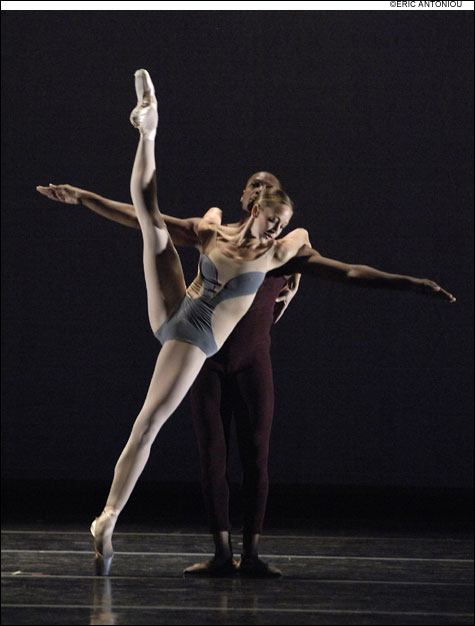
LITURGY: New York City Ballet principals Maria Kowroski and Albert Evans guested regally in
Christopher Wheeldon’s piece. |
Maybe it’s the economy, but Boston Ballet’s third-annual season-opening gala was a sober evening, without the orchestral overture and the Paris Opera Ballet–style défilé (a kind of company introduction in which the dancers come on stage one by one, to the cheers of his or her fans) that graced the first two affairs. It’s a smaller company now, with just seven principals and 40 dancers total. Many cities bigger than Boston would, of course, love to have a company of this quality. Some would even do more to support it.
As in the past two galas, the dancers got high marks for artistry and only middling ones for bravura. The excerpt from Jorma Elo’s In on Blue, which Boston Ballet premiered last March, made for an oddly dim-lit and low-key opener, but the echoes of Bernard Herrmann’s Vertigo music and the jittery questioning of ’50s attitudes about men and women made me want to see it again. The one commissioned premiere, former company principal Viktor Plotnikov’s Rhyme, was so mesmerizing that I didn’t even register the Chopin score, Larissa Ponomarenko and Yury Yanowsky moving toward and away from each other, lit and unlit, sometimes in spooky silence, a piece that made you think about its title.
New York City Ballet principals Maria Kowroski and Albert Evans guested in Christopher Wheeldon’s Liturgy, a spikier duet that, set to Arvo Pärt’s Fratres, sat regally on Pärt’s harmonic pulse points, the dancers sitting with it. John Lam was pellucid as a bemused Everyman contra mundum in William Forsythe’s The Vile Parody of Address. A slinky Misa Kuranaga in the Adam-and-Eve-like pas de deux from George Balanchine’s Rubies seemed more likely to seduce the Snake than vice versa; James Whiteside was big and boisterous (especially in his Rodeo moment) and an effective counterweight. The slow movement of Balanchine’s Concerto Barocco reminded me what a wonderful role this is for Pavel Gurevich, who remained upright and elegant while twining with the shorter women; his partner, Rie Ichikawa, failed only in her tendency to rush the music.
The party pieces were less successful. The highlight of the excerpts from Sabrina Matthews’s ein von viel was Freda Locker’s incisive playing of the Goldberg variations; the choreography, here realized by James Whiteside and Jared Redick, still looks ordinary by comparison. Erica Cornejo and Carlos Molina seemed wasted in the pas de deux from Spartacus, though Cornejo did a nice impression of Maria in West Side Story, and the one-hand-lift-while-running-around-the-stage drew oohs and aahs. Neither Roman Rykine in the pas de deux from The Sleeping Beauty nor Nelson Madrigal in the excerpts from Paquita managed more than a very modest manège; Rykine and Ponomarenko did bring off three snappy fish dives, and, in Paquita, Lorna Feijóo’s fouetté sequence was stellar. Spinning at one point in pirouette and then slowing as if deciding when to stop, Jaime Díaz promised the fireworks that are the Corsaire pas de deux’s raison d’être, but he never quite exploded, and though Melissa Hough whipped through her chaîné turns, she lacked personality (which she has) and abandon.
The capper was the ninth and last movement from Twyla Tharp’s In the Upper Room, which should bring any audience to its feet, but it didn’t quite come off: one of the Bomb Squad members slipped, and there was a fair bit of ragged ensemble and sloppy execution. Kathleen Breen Combes cut through the smoky haze with swivel hips that matched her smile.